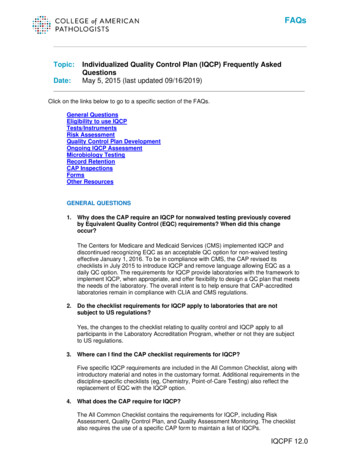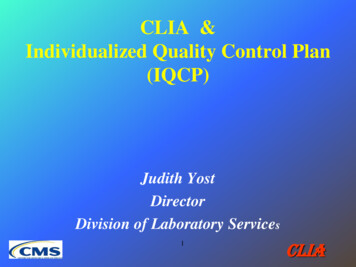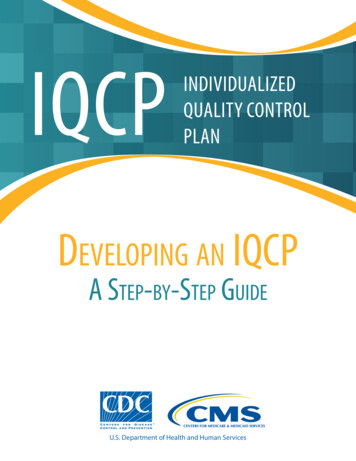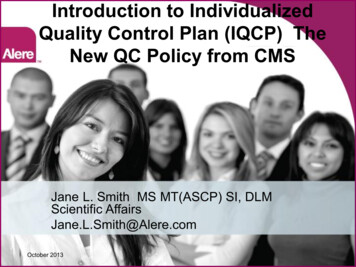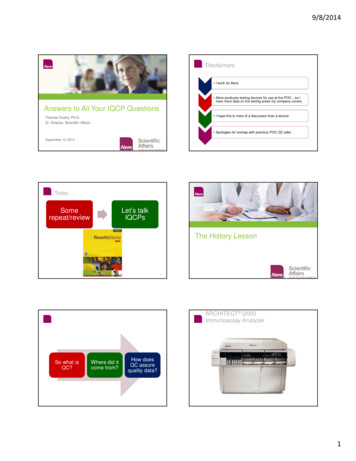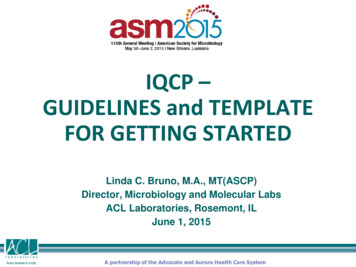
Transcription
IQCP –GUIDELINES and TEMPLATEFOR GETTING STARTEDLinda C. Bruno, M.A., MT(ASCP)Director, Microbiology and Molecular LabsACL Laboratories, Rosemont, ILJune 1, 2015A partnership of the Advocate and Aurora Health Care System
Disclosures- No disclosuresA partnership of the Advocate and Aurora Health Care System2
IQCP – OUTLINE IQCP applications in Microbiology Current and future CMS QCstandards for Microbiology Getting started on sample IQCPtemplateA partnership of the Advocate and Aurora Health Care System3
GOING AWAY 12/31/2015Equivalent Quality Control (EQC)Aka: QC performed once every 30 days andany frequency other than each day of patienttestingCOMING 1/1/2016Individualized Quality Control Plan (IQCP)Aka: QC frequency will need to be determinedbased on IQCP Risk AssessmentA partnership of the Advocate and Aurora Health Care System4
IQCP Applicationsin Microbiology?A partnership of the Advocate and Aurora Health Care System5
Microbiology –Test Systems where IQCP May ApplyAll QC not performed each day of testing forNON-WAIVED tests: ID systems (M50 Streamline), including Yeast IDsystems Sensitivity testing (eg Vitek, MicroScan, Etests,Disk diffusion testing) Rapid/Direct antigen kits (eg Rotavirus, RSV,Strep A, Legionella Urinary Antigen, Streppneumoniae urinary Antigen, Flu) Reagent tests (Refer to current CMS reqs) Exempt Culture Media Rapid Molecular tests (eg Illumigene, BioFire,Cepheid)A partnership of the Advocate and Aurora Health Care System6
Let’s look what is inCMS/CLIA StandardsAndWhat CLSI documents are beingDELETEDfrom the StandardsA partnership of the Advocate and Aurora Health Care System7
Current CMS Laboratory Standards*SubPart K Quality System for Nonwaived TestingQCPosNegQC Frequency: Each day of useD5473 493.1256AFB Stains (eg Kinyoun,Ziehl-Neelsen)YesYesD5501 493.1261Beta-lactamase otherthan CefinaseYesYes*CLIA Advance copy-revised Appendix C-Survey Procedures and InterpretiveGuidelines for Laboratories and Laboratory Services, Jan 9, 2015A partnership of the Advocate and Aurora Health Care System8
Current CMS Laboratory Standards*SubPart K Quality System for Nonwaived TestingQCPosNegYesYesQC Frequency: Each time of useD5475 493.1256Fluorescent stains(includes fluorochromeAFB) andimmunohistochemicalstains*CLIA Advance copy-revised Appendix C-Survey Procedures and InterpretiveGuidelines for Laboratories and Laboratory Services, Jan 9, 2015A partnership of the Advocate and Aurora Health Care System9
Current CMS Laboratory Standards*SubPart K Quality System for Nonwaived TestingQCPosNegQC Frequency: Each new batch, lot #, and shipmentD5471 seYesYesCoagulase plasmaYesYesGerm Tube testYesNo*CLIA Advance copy-revised Appendix C-Survey Procedures and InterpretiveGuidelines for Laboratories and Laboratory Services, Jan 9, 2015A partnership of the Advocate and Aurora Health Care System10
Current CMS Laboratory Standards*SubPart K Quality System for Nonwaived TestingQCPosNegQC Frequency: Each new batch, lot #, and shipmentD5471 493.1256 ONPG(e)(1)OptochinYesYesYesYesOxidaseSpot indoleYesYesYesYesX and V factor stripsand disksYesNo*CLIA Advance copy-revised Appendix C-Survey Procedures and InterpretiveGuidelines for Laboratories and Laboratory Services, Jan 9, 2015A partnership of the Advocate and Aurora Health Care System11
CLSI M50 being DELETED fromCMS Laboratory Standards*SubPart K Quality System for Nonwaived TestingQCPosNegQC Frequency: Each new lot # and shipmentD5471 493.1256 Identification systems(e)(1)YesYesCheck (systems using two or moresubstrates or two or more reagents, or acombination) when prepared or openedfor positive and negative reactivity ofeach substrate (includes mycology IDsystems)*CLIA Advance copy-revised Appendix C-Survey Procedures and InterpretiveGuidelines for Laboratories and Laboratory Services, Jan 9, 2015A partnership of the Advocate and Aurora Health Care System12
DELETED from CMS/CLIA CLSI M50 – Quality Control forCommercial Microbial IdentificationSystems Are you doing Stream-line QC ? If so, to continue stream-line QC you willneed to do an IQCPA partnership of the Advocate and Aurora Health Care System13
CLSI M22 being DELETED fromCMS Laboratory Standards*SubPart K Quality System for Nonwaived TestingChecksQC Frequency: Each new batch, lot #, and shipment –check before or concurrent with initial useD5477 493.1256 Media(e)(4)- Sterility- Ability to support growth- Select or inhibit specific organisms- Produce biochemical response- Document whencompromised deterioration *CLIA Advance copy-revised Appendix C-Survey Procedures and InterpretiveGuidelines for Laboratories and Laboratory Services, Jan 9, 2015A partnership of the Advocate and Aurora Health Care System14
Deleted from CMS/CLIA CLSI M22 – Quality Control forCommercially Prepared MicrobiologicalCulture Media (since 1986) Exempt culture media listed in Table 1B ofM22 will require IQCP (eg Blood agar, Thiobroth, urease agar, blood culture media,CNA, MacConkey etc) NOTE: CMS does not distinguish betweenexempt and non-exempt culture mediaA partnership of the Advocate and Aurora Health Care System15
Current CMS Laboratory Standards*SubPart K Quality System for Nonwaived TestingQCPosNegYesYesQC Frequency: Each week of useD5503 493.1261(a)(2)Gram stain*CLIA Advance copy-revised Appendix C-Survey Procedures and InterpretiveGuidelines for Laboratories and Laboratory Services, Jan 9, 2015A partnership of the Advocate and Aurora Health Care System16
Current CMS Laboratory Standards*SubPart K Quality System for Nonwaived TestingQCPosNegQC Frequency: Each lot # and shipment, and onceevery 6 monthsD5505 493.1261(a)(3)Salmonella and Shigellaantisera, streptococcalserotyping systemsYesYes*CLIA Advance copy-revised Appendix C-Survey Procedures and InterpretiveGuidelines for Laboratories and Laboratory Services, Jan 9, 2015A partnership of the Advocate and Aurora Health Care System17
CLSI M100 being DELETED fromCMS Laboratory Standards*SubPart K Quality System for Nonwaived TestingQCOrganismsQC Frequency: Each batch of media AND each lot #and shipment of antimicrobial agents before, orconcurrent with initial useD5507 493.1261 AntimicrobialYes(b)susceptibility test*CLIA Advance copy-revised Appendix C-Survey Procedures and InterpretiveGuidelines for Laboratories and Laboratory Services, Jan 9, 2015A partnership of the Advocate and Aurora Health Care System18
CLSI M100 being DELETED fromCMS Laboratory Standards*SubPart K Quality System for Nonwaived TestingQCOrganismsQC Frequency: Each day tests are performed, must useappropriate control organisms to check procedureD5507 493.1261 AntimicrobialYes(b)(1)susceptibility test*CLIA Advance copy-revised Appendix C-Survey Procedures and InterpretiveGuidelines for Laboratories and Laboratory Services, Jan 9, 2015A partnership of the Advocate and Aurora Health Care System19
Deleted from CMS/CLIA CLSI M100 – Performance Standards forAntimicrobial Susceptibility Testing All disk diffusion and MIC susceptibilitytesting with weekly QC will need IQCP Labs performing gradient MIC susceptibilitytesting with weekly QC will need IQCPA partnership of the Advocate and Aurora Health Care System20
CLSI References being DELETEDCMS/CLIA Clinical Lab Standards M100 Sensitivity QC M22 Media QC M50 Microbial ID Systems – Streamline QCA partnership of the Advocate and Aurora Health Care System21
Individualized Quality Control Plan(IQCP)1RiskAssessment2QualityControl Plan3QualityAssessmentIQCPA partnership of the Advocate and Aurora Health Care System22
Individualized Quality Control Plan(IQCP)1RiskAssessment2Quality ControlPlan3QualityAssessmentIQCPA partnership of the Advocate and Aurora Health Care System23
IQCP – Risk Assessment (RA)1. Risk Assessment: Five components that MUST be covered are: Specimen (collection, transport, integrity,receiving, processing ) Lab Environment (temperature, humidity,power failure ) Testing personnel (training, competency,proficiency testing, staffing ) Reagent/QC (shipping, storage, preparation,expiration date ) Test system (sample failure, reagent failure,software failure, hardware failure.) Test results (transmission of results )NOTE:May be separated out from Test SystemA partnership of the Advocate and Aurora Health Care System24
RISK ASSESSMENT:Identification of Potential ialHazardsReagent IntegrityQC Organism(s)4ReagentsIncorrect TestResultsInstrumentQC organism5Test SystemReportedResults6Test ResultsPre-analyticalAnalytical25 Post-analytical
RA - SpecimenReview all policies and procedures relating to: Patient identification Collection containers Specimen collection Specimen rejection criteria Labelling of containers Specimen volume Transport Storage HOW OFTEN WERE THERE ERRORS? AND WHAT WAS SEVERITY OF PATIENT HARM?A partnership of the Advocate and Aurora Health Care System26
RA – EnvironmentFactors that may affect test system: Temperature – review records Humidity – review records Ventilation Electric – are there power surges? Space – If cramped, could test system becompromised? Noise / vibration Water quality – does test system require DI water? Ifso, review those records HOW OFTEN DID ISSUES OCCUR? AND WHATWAS THE SEVERITY OF PATIENT HARM?A partnership of the Advocate and Aurora Health Care System27
RA – Testing PersonnelAre there records / documentation for: Training – checklists for each person trained toperform test? Competency assessment – is theredocumentation for each person performing thistest system or assay? Proficiency Testing –is there PT for this testsystem and is there remedial action forunsatisfactory results? Is it reviewed? Staffing – HOW OFTEN WERE THERE ISSUES? ANDWHAT WAS THE SEVERITY TO PATIENTHARM?A partnership of the Advocate and Aurora Health Care System28
RA - ReagentsReagent Integrity: Shipping and storage – any documented issues? Expiration dates – review policy and procedure –any issues? Reagent preparation – review policy andprocedure – any issues? QC – any issues? HOW OFTEN WERE THERE ISSUES? ANDWHAT WAS THE SEVERITY OF PATIENTHARM?A partnership of the Advocate and Aurora Health Care System29
RA – Test SystemInstrument / Assay: Software – documentation of installs, validationdata afterwards, any issues? Hardware or LIS interface – any issues Contamination Maintenance – review of all records, any trends orrecurring issues? Proper specimen sampling – any issues Calibration – any issues QC – any failures, review of all records HOW OFTEN WERE THERE ISSUES? ANDWHAT WAS THE SEVERITY OF PATIENTHARM?A partnership of the Advocate and Aurora Health Care System30
RA – Test SystemAlso review: Manufacturer’s package insert – what arethe limitations of the test / assay What are the interfering substances? Verification/validation data – review, anyissues? Physician or client complaintsA partnership of the Advocate and Aurora Health Care System31
RA – Test ResultsReported results: Transmission of results to HospitalInformation Systems (HIS) Review of released results Clinician feedback HOW OFTEN WERE THERE ISSUES?AND WHAT WAS THE SEVERITY OFPATIENT HARM?A partnership of the Advocate and Aurora Health Care System32
RA - Risk AssessmentAfter identifying all potential sources ofrisk/error for each of the five (5) or six (6)components: determine the “Frequency of occurrence”and the “Possible severity of harm” foreach risk identified, based on documentedrecords of failure or errorA partnership of the Advocate and Aurora Health Care System33
RA - Risk Assessment Why – do you want to do this?Per CMS“To conduct a risk assessment, the laboratorymust identify the sources of potential failuresand errors for a testing process, and evaluatethe frequency and impact of those failures andsources of error.”** CMS Ref: Survey and Certification: 13-54-CLIA,August 16, 2013A partnership of the Advocate and Aurora Health Care System34
RA – What Determines Frequency ofOccurrence and Severity of Harm?Review all failure/error data, how manytimes in a week, month, year did aparticular failure or error occur? Did it causeharm to the patient? Corrective action reportsProficiency Testing corrective actionRetraining of personnelTemperature out-of-control recordsQC failuresA partnership of the Advocate and Aurora Health Care System35
Determining Risk “Frequency of occurrence”How often does this error occur? Review all data todetermine frequency“Severity of harm”When error occurred, what was the harm to thepatient or possible harm that could be to the patient?A partnership of the Advocate and Aurora Health Care System36
Determining Risk – Example 4 levelsFrequency ofOccurrenceSeverity of HarmUnlikely (once /2-3 yrs)Negligible (temporarydiscomfort)Occasional (1/yr)Minor (temporary injury; notrequiring medical intervention)Probable (1/mo)Serious (impairment requiringmedical intervention)Frequent (1/wk)Critical (permanentimpairment requiring medicalintervention)A partnership of the Advocate and Aurora Health Care System37
Determining Risk – Example 5 levelsFrequency of Occurrence Severity of HarmRare (once /2-3 yrs)Negligible (temporarydiscomfort)Unlikely (1/yr)Minor (temporary injury; notrequiring medical intervention)Moderate (may require medicalintervention)Possible (1/mo)Likely (2/mo)Serious (impairment requiringmedical intervention)Almost certain (1/wk)Critical (permanent impairmentrequiring medical intervention)A partnership of the Advocate and Aurora Health Care System38
Risk Matrix from CLSI EP-23Severity of harm (Impact)Probabilityof moteAAAUUImprobableAAAAAA Acceptable riskU Unacceptable risk39
Risk Assessment Table The following table is an example of how topresent the risk. Table/grid represents eachof the five or six components and the identified related risk/error frequency of occurrence and severity of harm Measures to control risk Relevant SOPA partnership of the Advocate and Aurora Health Care System40
RISK ASSESSMENT:Identification of Potential ialHazardsReagent IntegrityQC Organism(s)4ReagentsIncorrect TestResultsInstrumentQC organism5Test SystemReportedResults6Test ResultsPre-analyticalAnalytical41 Post-analytical
Risk Assessment – SpecimenEXAMPLE of TABLE FORMAT1SpecimenList each riskidentifiedFrequency SeverityofofOccurrence HarmMeasures tocontrol riskListListList how risk will befrequency of degree of controlledoccurrence severityof harmRelevantSOPReferenceSOP thatsupportcontrolmeasure Repeat this process for each component and all risksidentified under that component UNACCEPTABLE risks must be included in Quality Control Plan ACCEPTABLE risks may be included in the Quality Control Planat the discretion of the Laboratory Director.A partnership of the Advocate and Aurora Health Care System42
Individualized Quality Control Plan(IQCP)1RiskAssessment2Quality ControlPlan3QualityAssessmentIQCPA partnership of the Advocate and Aurora Health Care System43
Quality Control Plan (QCP) Resulting “Risk Assessment” is then usedto develop the Quality Control Plan (QCP)Risks identified as UNACCEPTABLE mustbe included in QCP and address: How will these risks be controlled? How often does QC need to beperformed based on the potential risksidentified? What QC material needs to be used? What is the criteria for QCacceptability?A partnership of the Advocate and Aurora Health Care System44
Quality Control Plan (QCP)What Is It?Document (or chart/table) that describes practices,resources, and procedures used to control the quality ofa test system. Must monitor accuracy and precision of testperformance MUST include: number of QC, type of QC, frequency of QC and define criteria for acceptability of QC MUST have Lab Director’s review, approval,signature (this cannot be delegated) NOTE: Lab Director is the name on the lab CLIAlicenseA partnership of the Advocate and Aurora Health Care System45
Individualized Quality Control Plan(IQCP)1RiskAssessment2Quality ControlPlan3QualityAssessmentIQCPA partnership of the Advocate and Aurora Health Care System46
Quality Assessment - OverviewLaboratory must establish a review systemfor on-going monitoring of effectiveness oftheir QCP.Monitoring must include at least thefollowing: Specimens Testing personnel Testing environment Test reagents Test systemA partnership of the Advocate and Aurora Health Care System47
Quality Assessment – Overview(cont)When a testing process failure isdiscovered, lab must conduct anddocument an investigation to: Identify cause of the failure, its impact on patient care, and make appropriate modifications to theirQCP Modifications will need review andapproval by Lab Director QCP signed / dated againA partnership of the Advocate and Aurora Health Care System48
Individualized Quality Control Plan(IQCP)1RiskAssessment2QC Plan3QualityAssessmentIQCPA partnership of the Advocate and Aurora Health Care System49
References CLIA Advance copy-revised Appendix C- SurveyProcedures and Interpretive Guidelines forLaboratories and Laboratory Services, Jan 9, 2015CMS Ref: Survey and Certification: 13-54-CLIA,August 16, 2013A partnership of the Advocate and Aurora Health Care System50
THANK YOUA partnership of the Advocate and Aurora Health Care System51
A partnership of the Advocate and Aurora Health Care System IQCP - GUIDELINES and TEMPLATE FOR GETTING STARTED Linda C. Bruno, M.A., MT(ASCP) Director, Microbiology and Molecular Labs
